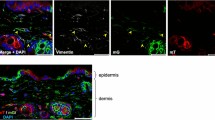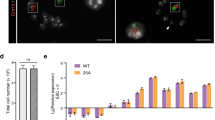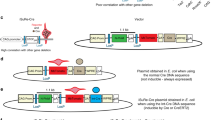Abstract
We have developed a strategy for chromosome engineering in embryonic stem (ES) cells that relies on sequential gene targeting and Cre–loxP site–specific recombination. Gene targeting was first used to integrate loxP sites at the desired positions in the genome. Transient expression of Cre recombinase was then used to mediate the chromosomal rearrangement. A genetic selection relying on reconstruction of a selectable marker from sequences co–integrated with the loxP sites allowed detection of cells containing the Cre–mediated rearrangement. A programmed translocation between the c–myc and immunoglobulin heavy chain genes on chromosomes 15 and 12 was created by this method. This strategy will allow the design of a variety of chromosome rearrangements that can be selected and verified in ES cells or activated in ES cell–derived mice.
This is a preview of subscription content, access via your institution
Access options
Subscribe to this journal
Receive 12 print issues and online access
$209.00 per year
only $17.42 per issue
Buy this article
- Purchase on Springer Link
- Instant access to full article PDF
Prices may be subject to local taxes which are calculated during checkout
Similar content being viewed by others
References
Capecchi, M. Altering the genome by homologous recombination. Science 244, 1288–12921 (1989).
Koller, B.H. & Smithies, O. Altering genes in animals by gene targeting. Annu. rev. Immunol. 10, 705–730 (1992).
Evans, M. Potential for genetic manipulation of mammals. Molec. biol. Med. 6, 557–665 (1989).
Craig, N.C. The mechanism of site-specific recombination. Annu. Rev. Genet. 22, 77–105 (1988).
Stark, W.M., Boocock, M.R. & Sherratt, D.J. Catalysis by site-specific recombinases. Trends Genet. 8, 432–439 (1992).
Stemberg, N. & Hamilton, D. Bacteriophage P1 site-specific recombination. I. Recombination between loxP sites. J. molec. Biol. 150, 467–486 (1981).
Yarmolinsky, M.B. & Sternberg, N., Bacteriophage P1. The Bacteriophages Vol.1, (Ed. Calender, R.) 291–438 (Plenum, 1988).
Hoess, R.H. & Abremski, K. Interaction of bacteriophage P1 recombinase with the recombining site loxP. Proc. natn. Acad. Sci. U.S.A. 81, 1026–1029 (1984).
Hoess, R. & Abremski, K. Mechanism of strand cleavage and exchange in the Cre-lox site specific recombination system. J. molec. Biol. 181, 351–362 (1985).
Hoess, R.H., Wierzbicki, A. & Abremski, K. The role of the loxP spacer in P1 site-specific recombination. Nuc. Acids Res. 14, 2287–2300 (1986).
Abremski, K., Hoess, R. & Sternberg, N. Studies on the properties of P1 site-specific recombination: evidence for topologically unlinked products following recombination. Cell 32, 1301–1311 (1983).
Gage, P.J., Sauer, B., Levine, M. & Glorioso, J.C. A cell-free recombination system for site-specific integration of multlgenic shuttle plasmids into the herpes simplex virus type I genome. J. Virol. 66, 5509–5515 (1992).
Elledge, S.J., Mulligan, J.T., Ramer, S.W., Spotswood, M. & Davis, R.W. λYES: a functional cDNA expression vector for the isolation of genes by complementation of yeast and Escherichia coli mutations. Proc. natn. Acad. Sci. U.S.A. 88, 1731–1735 (1991).
Sauer, B. Functional expression of the cre-loxP site-specific recombination system in the yeast Saccharomyces cerevisiae. Molec. cell. Biol. 7, 2087–2096 (1987).
Dale, E.C. & Ow, D.W. Intra-and intermolecular site-specific recombination in plant cells mediated by bacteriophage P1 recombinase. Gene 91, 79–85 (1990).
Sauer, B. & Henderson, N. Site-specific recombination in mammalian cells by the Cre recombinase of bacteriophage P1. Proc. natn. Acad. Sci. U.S.A. 85, 5166–5170 (1991).
Sauer, B. & Henderson, N. Cre-stimulated recombination at loxP sites placed into the genome of mammalian cells. Nucl. Acids Res. 17, 147–161 (1989).
Gu, H., Zou, Y.R. & Rajewsky, K. Independent control of immunoglobulin switch recombination at individual switch regions evidenced through Cre-loxP mediated gene targeting. Cell 73, 1155–1164 (1993).
Sauer, B. & Henderson, N. Targeted insertion of exogenous DNA into the eukaryotic genome by the Cre recombinase. New Biologist 2, 441–449 (1990).
Hooper, M., Hardy, K., Handyside, A., Hunter, S. & Monk, M. HPRT deficient (Lesch-Nyhan) mouse embryos derived from germline colonization by cultured cells. Nature 326, 292–295 (1987).
Reid, L.H., Gregg, R.G., Smithies, O. & Koller, B.H. Regulatory elements in the introns of the human Hprt gene are necessary for its expression in embryonic stem cells. Proc. natn. Acad. Sci. U.S.A. 87, 4299–4303 (1990).
Potter, M. & Wiener, F. Plasmacytomagenesis in mice: model of neoplastic development dependent upon chromosomal translocations. Carcinogenesis 13, 10 1681–1687 (1992).
Cory, S. Activation of cellular oncogenes in hematopoetic cells by chromosome translocation. Adv. Cancer Res. 47, 189–211 (1986).
Mansour, S.L., Thomas, K.R. & Capecchi, M.R. Disruption of the proto-oncogene Int-2 in mouse embryo derived stem cells: a general strategy for targeting mutations to non-selectable genes. Nature 336, 348–352 (1988).
Rabbitts, P.H. et al. Chromosome-specific paints from a high resolution flow karyotype of the mouse. Nature Genet. 9, 369–375 (1995).
Rouyer, F., Simmler, M.-C., Page, D.C. & Wissenback, J.,A sex chromosome rearrangement In a human XX male caused by Alu-Alu recombination. Cell 51, 417–425 (1987).
Yen, P.H. et al. X/Y translocations resulting from recombination between homologous sequences on Xp and Yq. Proc. natn. Acad. Sci. U.S.A. 88, 8944–8948 (1990).
Matsuzaki, H., Nakajima, R., Nishiyama, J., Araki, H. & Oshima, Y. Chromosome engineering in Saccharomyces cerevisiae by using a site-specific recombination system of a yeast plasmid. J. Bact. 172, 610–618 (1990).
Golic, K.G. Site-specific recombination between homologous chromosomes in Drosophila. Science 252, 958–961 (1991).
Quin, M., Bayley, C., Stockton, T. & Ow, D.W. Cre recombinase-mediated site-specific recombination between plant chromosomes. Proc. natn. Acad. Sci. U.S.A. 91, 1706–1710 (1994).
Matsuzaki, H., Araki, H. & Oshima, Y. Gene conversion associated with site-specific recombination in yeast plasmid pSR1. Molec. cell. Biol. 8, 955–962 (1988).
Cox, M. FLP site-specific recombination system of Saccharomyces cerevisiae. in Genetic Recombination (eds Kucherlapati, R. and Smith, G.R.) 429–433 (American Society for Microbiology, Washington, DC, 1988).
Gu, H., Marth, J.D., Orban, P.C., Mossmann, H. & Rajewsky, K. Deletion of polymerase β gene segment in T cells using cell type-specific gene targeting. Science 265, 103–106 (1994).
Nehls, M., Messerie, M., Sirulnik, A., Smith, A.J.H. & Boehm, T. Two large Insert vectors, λPS and λKO facilitate rapid mapping and targeted disruption of mammalian genes. Biotechniques 17, 770–775 (1994).
Thomas, K.R. & Capecchi, M.R. Site-directed mutagenesis by gene targeting in mouse embryo-derived stem cells. Cell 58, 313–321 (1987).
Yenofsky, R.L., Fine, M. & Pellow, J.W. A mutant neomycin phosphotransferase II gene reduces the resistance of transformants to antibiotic selection pressure. Proc. natn. Acad. Sci. U.S.A. 87, 3435–3439 (1990).
Tybulewicz, V.L.J., Crawford, C.E., Jackson, P.K., Branson, R.T. & Mulligan, R.C. Neonatal lethality and lymphopenia in mice with a homozygous disruption of the c- abl proto-oncogene. Cell 65, 1153–1163 (1991).
te Riele, H., Maandag, E.R., Clarke, A., Hooper, M. & Berns, A. Consecutive inactivation of both alleles of the pim-1 proto-oncogene by homologous recombination in embryonic stem cells. Nature 348, 649–651 (1990).
Author information
Authors and Affiliations
Rights and permissions
About this article
Cite this article
Smith, A., De Sousa, M., Kwabi-Addo, B. et al. A site–directed chromosomal translocation induced in embryonic stem cells by Cre-loxP recombination. Nat Genet 9, 376–385 (1995). https://doi.org/10.1038/ng0495-376
Received:
Accepted:
Issue Date:
DOI: https://doi.org/10.1038/ng0495-376
This article is cited by
-
Development of a Cre-loxP-based genetic system in Aspergillus niger ATCC1015 and its application to construction of efficient organic acid-producing cell factories
Applied Microbiology and Biotechnology (2019)
-
Generation of megabase-scale deletions, inversions and duplications involving the Contactin-6 gene in mice by CRISPR/Cas9 technology
BMC Genetics (2017)
-
Revealing hidden complexities of genomic rearrangements generated with Cas9
Scientific Reports (2017)
-
Generation of an 870 kb deletion encompassing the Skt/Etl4 locus by combination of inter- and intra-chromosomal recombination
BMC Genetics (2015)
-
Somatic chromosomal translocation between Ewsr1 and Fli1 loci leads to dilated cardiomyopathy in a mouse model
Scientific Reports (2015)



